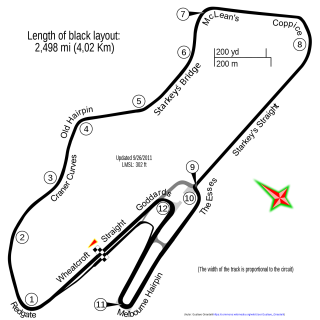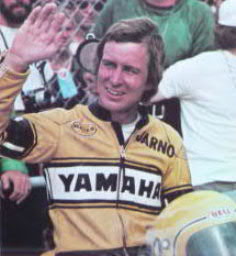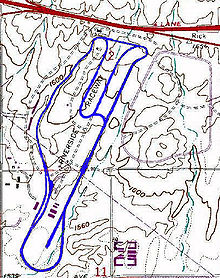
The Isle of Man TT or Tourist Trophy races are an annual motorcycle racing event run on the Isle of Man in May and June of most years since its inaugural race in 1907. The event begins on the UK Spring Bank Holiday at the end of May and runs for thirteen days. It is often called one of the most dangerous racing events in the world as many competitors have died.

John Norman Surtees, was a British Grand Prix motorcycle road racer and Formula One driver. On his way to become a seven-time Grand Prix motorcycle World Champion, he won his first title in 1956, and followed with three consecutive doubles between 1958 and 1960, winning six World Championships in both the 500 and 350cc classes. Surtees then made the move to the pinnacle of Motorsport, the Formula 1 World Championship, and in 1964 made motor racing history by becoming the F1 World Champion. To this day Surtees remains the only person to have won World Championships on both two and four wheels. He founded the Surtees Racing Organisation team that competed as a constructor in Formula One, Formula 2 and Formula 5000 from 1970 to 1978. He was also the ambassador of the Racing Steps Foundation.

Donington Park is a motorsport circuit located near Castle Donington in Leicestershire, England. The circuit business is now owned by Jonathan Palmer's MotorSport Vision organisation, and the surrounding Donington Park Estate, still owned by the Wheatcroft family, is currently under lease by MotorSport Vision until 2038. It has a capacity of 120,000, and is also the venue of the Download Festival.

The Imola Circuit, officially called the Autodromo Internazionale Enzo e Dino Ferrari, is a 4.909 km (3.050 mi) motor racing circuit. It is located in the town of Imola, in the Emilia-Romagna region of Italy, 40-kilometre (25 mi) east of Bologna. It is one of the few major international circuits to run in an anti-clockwise direction. Initially used for motorcycle racing, the first race at Imola was held in 1953.

The Monza Circuit is a 5.793 km (3.600 mi) race track near the city of Monza, north of Milan, in Italy. Built in 1922, it was the world's third purpose-built motor racing circuit after Brooklands and Indianapolis and the oldest in mainland Europe. The circuit's biggest event is the Italian Grand Prix. With the exception of the 1980 running when the track was closed while undergoing refurbishment, the race has been hosted there since 1949.

Robert Hugh Fearon Anderson was a British Grand Prix motorcycle road racer and racing driver. He competed in Grand Prix motorcycle racing from 1958 to 1960 and in Formula One from 1963 to the 1967 seasons. He was also a two-time winner of the North West 200 race in Northern Ireland. Anderson was one of the last independent privateer drivers in Formula One before escalating costs made it impossible to compete without sponsorship.

Stanley Michael Bailey Hailwood, was an English professional motorcycle racer and racing driver. He is regarded by many as one of the greatest racers of all time. He competed in the Grand Prix motorcycle world championships from 1958 to 1967 and in Formula One between 1963 and 1974. Hailwood was known as "Mike The Bike" because of his natural riding ability on motorcycles with a range of engine capacities.

The Circuit de Charade, also known as Circuit Louis Rosier and Circuit Clermont-Ferrand, is a motorsport race track in Saint-Genès-Champanelle near Clermont-Ferrand in the Puy-de-Dôme department in Auvergne in central France. The circuit, built around the base of an extinct volcano, was known for its challenging layout which favored the most skillful drivers and motorcyclists. It hosted the French Grand Prix four times and the French motorcycle Grand Prix ten times.

Giacomo Agostini is an Italian former Grand Prix motorcycle road racer. Nicknamed Ago, he amassed 122 Grand Prix wins and 15 World Championship titles. Of these, 68 wins and 8 titles came in the 500 cc class, the rest in the 350 cc class. For these achievements obtained over the course of a career spanning 17 years, the AMA described him as "...perhaps the greatest Grand Prix rider of all time". In 2000, Agostini was inducted into the MotoGP Hall of Fame as a MotoGP Legend, while in 2010, he was named an FIM Legend for his motorcycling achievements.

The Macau Grand Prix is a motorsport road race for automobiles and motorcycles held annually in Macau. It is the only street circuit racing event in which both cars and motorcycles participate.

Jarno Karl Keimo Saarinen was a Finnish professional Grand Prix motorcycle road racer. In the early 1970s, he was considered one of the most promising and talented motorcycle racers of his era until he was killed during the 1973 Nations Grand Prix in Italy. Saarinen's death led to increased demands for better safety conditions for motorcycle racers competing in the world championships. He remains the only Finn to have won a motorcycle road racing world championship. Saarinen was inducted into the F.I.M. MotoGP Hall of Fame in 2009.

Pat Hennen is an American former professional motorcycle racer. He competed in AMA dirt track and road racing competitions from 1971 to 1975 and in the Grand Prix motorcycle racing world championships from 1976 to 1978.

The Isle of Man TT Mountain Course or TT Course is a street and public rural road circuit located in the Isle of Man, used for motorcycle racing. The motorcycle TT Course is used principally for the Isle of Man TT Races and also the separate event of the Isle of Man Festival of Motorcycling for the Manx Grand Prix and Classic TT Races held in September of each year. The start-line for the Isle of Man TT Mountain Course is located on Glencrutchery Road in the town of Douglas, Isle of Man.
Graeme Crosby is a former professional Grand Prix motorcycle road racer from New Zealand. A versatile rider, Crosby was equally capable on either four stroke Superbike racers or two stroke Grand Prix racers. He is the only person to have won the Daytona 200, the Imola 200, the Suzuka 8 Hours endurance race, and the Isle of Man TT.
The Verandah, Isle of Man is a series of four bends which motorcyclists negotiate at high speed during road racing on the Snaefell Mountain Course on the Isle of Man.

Motorsport is a popular sport in the United Kingdom. The United Kingdom is a key player in the world of motorsport, hosting rounds of the Formula One World Championship and Grand Prix motorcycle racing, amongst others. It is also the home of many of the current teams in Formula One, such as McLaren, Williams and Aston Martin, while teams such as Red Bull Racing, Mercedes, Alpine and Haas are also based in England. There are also a range of popular national series held such as the British Touring Car Championship and the British GT Championship amongst others. The Motor Sports Association is the official governing body of motorsport in the United Kingdom.
Steve Linsdell is a British former professional motorcycle road racer. He specialized in a branch of road racing known as traditional road racing held on street circuits such as the North West 200 and the Ulster Grand Prix.

Dundrod Circuit is a motorsport street circuit used for the Ulster Trophy for Formula One and Formula Two cars from 1950 to 1953, the RAC Tourist Trophy for sports cars between 1950 and 1955, and for the motorcycle Ulster Grand Prix from 1953 onwards. It is situated near the village of Dundrod in Lisburn, Northern Ireland. The nearby Clady Circuit also in County Antrim was used for the Ulster Grand Prix between (1922–1952) before moving to the Dundrod Circuit.

Electric motorsport is a category of motor sport that consists of the racing of electric powered vehicles for competition, either in all-electric series, or in open-series against vehicles with different powertrains. Very early in the history of automobiles, electric cars held several performance records over internal combustion engine cars, such as land speed records, but fell behind in performance during the first decade of the 20th century.





















